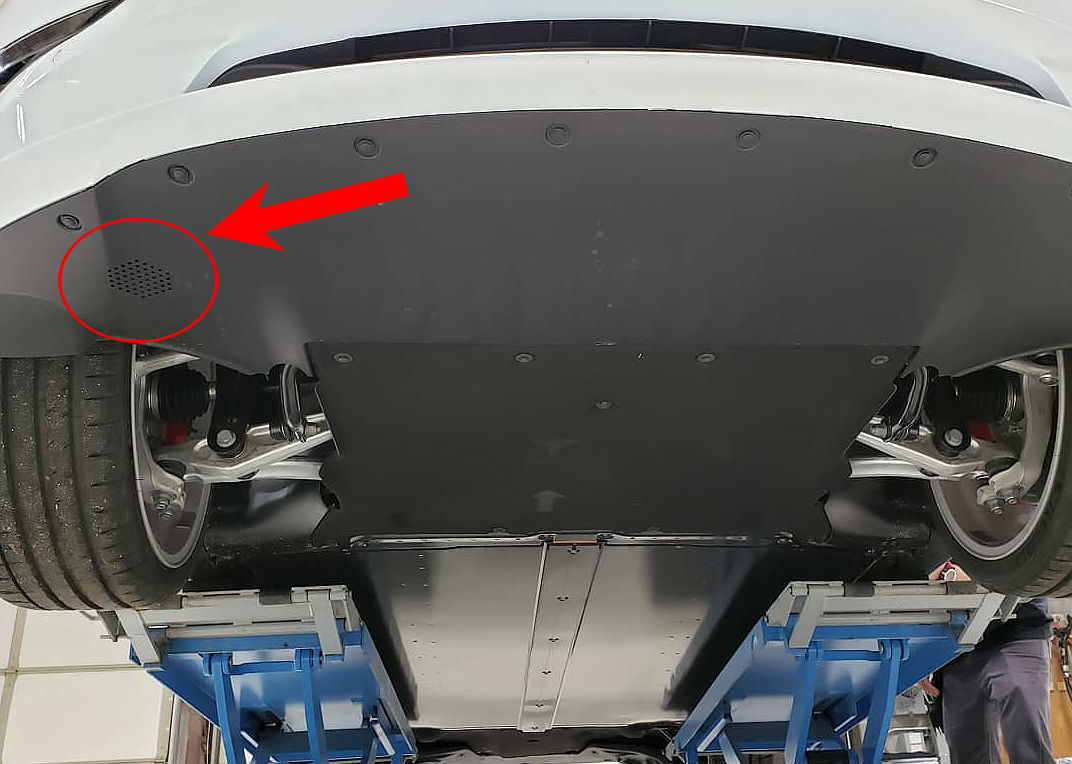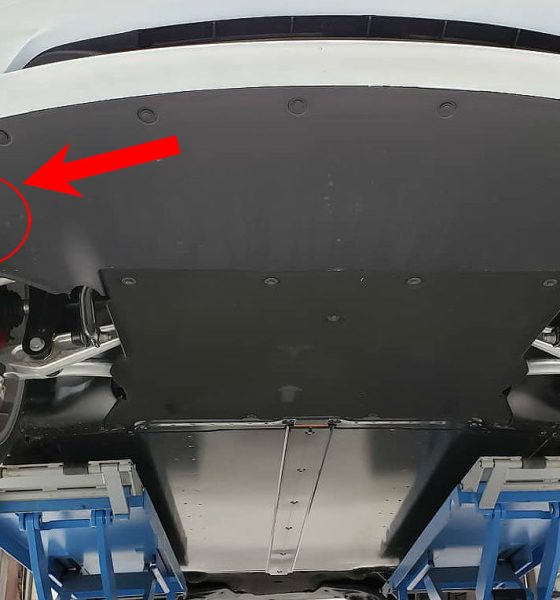

News
Tesla plans to retrofit its pedestrian warning system in older vehicles
Tesla is reportedly planning to retrofit its Pedestrian Warning System (PWS) into older Model 3s and Model Ys that were built between specific dates.
For those who aren’t aware, Tesla was required to create and install a PWS in its vehicles due to an NHTSA mandate that set requirements for electric vehicles to make noise when traveling at a speed below 19 MPH. The reasoning was based on the safety of pedestrians who would be walking near an electric vehicle. Due to the lack of a combustion engine in an EV, the cars are extremely quiet when traveling at low rates of speed. While great for noise pollution, it can be somewhat dangerous to pedestrians, especially ones who have vision issues or are blind. The mandate was established by the NHTSA with the Pedestrian Safety Enhancement Act of 2010, and all EV makers had until September 1, 2020, to install noisemakers on their vehicles.
First look at Tesla Model 3’s pedestrian noisemaker in action
In typical Tesla fashion, the company didn’t wait until the mandate was required and took action immediately. Model 3s delivered to customers in early September 2019 were outfitted with the noisemaker. An employee of the automaker also stated that all Model 3s built on September 1, 2019, and after would automatically be equipped with the noisemaker. Tesla Owners Online founder and Model 3 owner Trevor Page initially spoke to the employee who confirmed the presence of the Model 3 noisemaker in September 2019.
Page has now also confirmed with a Tesla source that the PWS can be retrofitted in Model 3 vehicles built between July 5, 2019, through September 9, 2020. Page said on his original posting that “this period represents the timing of when the wiring harness was included but not the speaker.” Page added that Model Ys built before August 14th also qualify and that the cost will be $200. It will require a mobile and service visit, and a technician must install it so that the car can identify it.
? BREAKING: Pedestrian warning system speaker retrofits available! More info here: https://t.co/DkYvdzYCWk@elonmusk pic.twitter.com/75f0PeZyln
— Tesla Owners Online (@Model3Owners) April 30, 2021
“Refer to Tesla SI-21-90-001 when you make an appointment to have it installed for reference,” Page advised.
Page also broke the story of the noisemakers being installed in late 2019.
The retrofit for the PWS isn’t all about safety, though. It also holds some entertainment benefits. The speaker is utilized by Tesla’s Boombox feature that was added with the Version 10 Software. This allows owners to play sounds audibly for those outside the vehicle to hear, and custom noises have become quite the buzz on some social media outlets like TikTok, where Tesla owners show the vast array of audio selections that they choose to play for spectators. Musk considered this addition in late 2020, and it appears that Service techs will now install the external speaker for those vehicles that qualify.
Will you equip your vehicle with the PWS? Let us know in the comments if you will or won’t, and explain your decision. You can also reach me personally at joey@teslarati.com or @KlenderJoey on Twitter.

Elon Musk
Elon Musk and Tesla AI Director share insights after empty driver seat Robotaxi rides
The executives’ unoccupied tests hint at the rapid progress of Tesla’s unsupervised Robotaxi efforts.

Tesla CEO Elon Musk and AI Director Ashok Elluswamy celebrated Christmas Eve by sharing personal experiences with Robotaxi vehicles that had no safety monitor or occupant in the driver’s seat. Musk described the system’s “perfect driving” around Austin, while Elluswamy posted video from the back seat, calling it “an amazing experience.”
The executives’ unoccupied tests hint at the rapid progress of Tesla’s unsupervised Robotaxi efforts.
Elon and Ashok’s firsthand Robotaxi insights
Prior to Musk and the Tesla AI Director’s posts, sightings of unmanned Teslas navigating public roads were widely shared on social media. One such vehicle was spotted in Austin, Texas, which Elon Musk acknowleged by stating that “Testing is underway with no occupants in the car.”
Based on his Christmas Eve post, Musk seemed to have tested an unmanned Tesla himself. “A Tesla with no safety monitor in the car and me sitting in the passenger seat took me all around Austin on Sunday with perfect driving,” Musk wrote in his post.
Elluswamy responded with a 2-minute video showing himself in the rear of an unmanned Tesla. The video featured the vehicle’s empty front seats, as well as its smooth handling through real-world traffic. He captioned his video with the words, “It’s an amazing experience!”
Towards Unsupervised operations
During an xAI Hackathon earlier this month, Elon Musk mentioned that Tesla owed be removing Safety Monitors from its Robotaxis in Austin in just three weeks. “Unsupervised is pretty much solved at this point. So there will be Tesla Robotaxis operating in Austin with no one in them. Not even anyone in the passenger seat in about three weeks,” he said. Musk echoed similar estimates at the 2025 Annual Shareholder Meeting and the Q3 2025 earnings call.
Considering the insights that were posted Musk and Elluswamy, it does appear that Tesla is working hard towards operating its Robotaxis with no safety monitors. This is quite impressive considering that the service was launched just earlier this year.
Elon Musk
Starlink passes 9 million active customers just weeks after hitting 8 million
The milestone highlights the accelerating growth of Starlink, which has now been adding over 20,000 new users per day.

SpaceX’s Starlink satellite internet service has continued its rapid global expansion, surpassing 9 million active customers just weeks after crossing the 8 million mark.
The milestone highlights the accelerating growth of Starlink, which has now been adding over 20,000 new users per day.
9 million customers
In a post on X, SpaceX stated that Starlink now serves over 9 million active users across 155 countries, territories, and markets. The company reached 8 million customers in early November, meaning it added roughly 1 million subscribers in under seven weeks, or about 21,275 new users on average per day.
“Starlink is connecting more than 9M active customers with high-speed internet across 155 countries, territories, and many other markets,” Starlink wrote in a post on its official X account. SpaceX President Gwynne Shotwell also celebrated the milestone on X. “A huge thank you to all of our customers and congrats to the Starlink team for such an incredible product,” she wrote.
That growth rate reflects both rising demand for broadband in underserved regions and Starlink’s expanding satellite constellation, which now includes more than 9,000 low-Earth-orbit satellites designed to deliver high-speed, low-latency internet worldwide.
Starlink’s momentum
Starlink’s momentum has been building up. SpaceX reported 4.6 million Starlink customers in December 2024, followed by 7 million by August 2025, and 8 million customers in November. Independent data also suggests Starlink usage is rising sharply, with Cloudflare reporting that global web traffic from Starlink users more than doubled in 2025, as noted in an Insider report.
Starlink’s momentum is increasingly tied to SpaceX’s broader financial outlook. Elon Musk has said the satellite network is “by far” the company’s largest revenue driver, and reports suggest SpaceX may be positioning itself for an initial public offering as soon as next year, with valuations estimated as high as $1.5 trillion. Musk has also suggested in the past that Starlink could have its own IPO in the future.
News
NVIDIA Director of Robotics: Tesla FSD v14 is the first AI to pass the “Physical Turing Test”
After testing FSD v14, Fan stated that his experience with FSD felt magical at first, but it soon started to feel like a routine.

NVIDIA Director of Robotics Jim Fan has praised Tesla’s Full Self-Driving (Supervised) v14 as the first AI to pass what he described as a “Physical Turing Test.”
After testing FSD v14, Fan stated that his experience with FSD felt magical at first, but it soon started to feel like a routine. And just like smartphones today, removing it now would “actively hurt.”
Jim Fan’s hands-on FSD v14 impressions
Fan, a leading researcher in embodied AI who is currently solving Physical AI at NVIDIA and spearheading the company’s Project GR00T initiative, noted that he actually was late to the Tesla game. He was, however, one of the first to try out FSD v14.
“I was very late to own a Tesla but among the earliest to try out FSD v14. It’s perhaps the first time I experience an AI that passes the Physical Turing Test: after a long day at work, you press a button, lay back, and couldn’t tell if a neural net or a human drove you home,” Fan wrote in a post on X.
Fan added: “Despite knowing exactly how robot learning works, I still find it magical watching the steering wheel turn by itself. First it feels surreal, next it becomes routine. Then, like the smartphone, taking it away actively hurts. This is how humanity gets rewired and glued to god-like technologies.”
The Physical Turing Test
The original Turing Test was conceived by Alan Turing in 1950, and it was aimed at determining if a machine could exhibit behavior that is equivalent to or indistinguishable from a human. By focusing on text-based conversations, the original Turing Test set a high bar for natural language processing and machine learning.
This test has been passed by today’s large language models. However, the capability to converse in a humanlike manner is a completely different challenge from performing real-world problem-solving or physical interactions. Thus, Fan introduced the Physical Turing Test, which challenges AI systems to demonstrate intelligence through physical actions.
Based on Fan’s comments, Tesla has demonstrated these intelligent physical actions with FSD v14. Elon Musk agreed with the NVIDIA executive, stating in a post on X that with FSD v14, “you can sense the sentience maturing.” Musk also praised Tesla AI, calling it the best “real-world AI” today.








